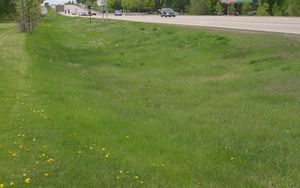
Overview for dry swale (grass swale)
This site is in development
Dry swales, sometimes called grass swales, are similar to bioretention cells but are configured as shallow, linear channels. Dry swales function primarily as a conveyance BMP, but provide treatment of stormwater runoff, particularly when used in tandem with check dams that temporarily retain water in a series of cells. Dry swales are designed to prevent standing water. The filter bed consists of a sandy loam subsoil or engineered soil media mix, which allows the water to filter through and remove some pollutants. Dry swale design may also include an underdrain that carries away water in the drain pipe after it has filtered through the base media. Dry swales may thus be constructed as filtration or infiltration practices, depending on soils. If soils are highly permeable (A or B soils), runoff infiltrates into underlying soils. In less permeable soils, runoff is treated by engineered soil media and flows into an underdrain. Dry swales typically have vegetative cover such as turf or native perennial grasses.
In the following discussion, swales are identified as filtration/infiltration practices. Swales are considered filtration practices when an underdrain is employed and infiltration practices when an underdrain is absent. Check dams may be utilized for either configuration. Engineered media is typically utilized in filtration swales and not utilized for infiltration swales.
Function within the treatment train
Dry swales may be located at the end of the treatment train, the main form of conveyance between or out of BMPs, or designed as off-line configurations where the water quality volume is diverted to the filtration/infiltration practice. In any case, the practice may be applied as part of a stormwater management system to achieve one or more of the following objectives:
- reduce stormwater pollutants
- increase groundwater recharge
- decrease runoff peak flow rates
- decrease the volume of stormwater runoff
- preserve base flow in streams
- reduce thermal impacts of runoff
